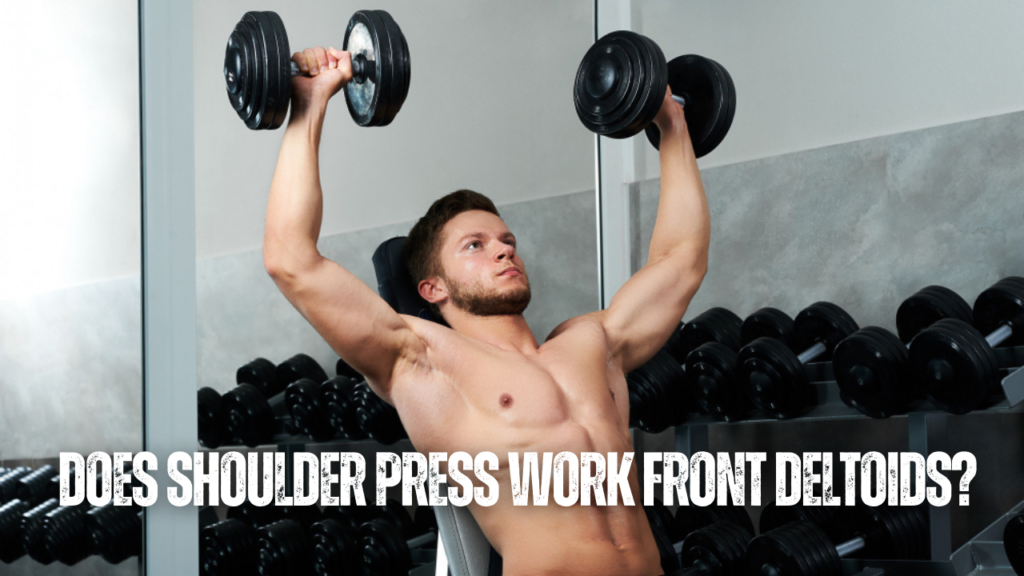
Does Shoulder Press Work Front Deltoids? All You Need To Know
The shoulder press is a popular exercise for building upper body strength and improving shoulder mobility. However, many people wonder whether this exercise effectively targets the front deltoids, or whether it primarily works other muscles in the shoulder and upper body.
The answer to this question is not straightforward, as there are a number of factors that can affect the activation of the front deltoids during a shoulder press.
In this article, we will explore the shoulder press and its effects on the front deltoids, as well as provide tips for optimising this exercise to target this muscle group effectively. Whether you’re a fitness enthusiast looking to improve your shoulder strength or a trainer looking to optimize your clients’ workouts, understanding the mechanics of the shoulder press and its effects on the front deltoids is essential for achieving your goals.
Does Shoulder Press Work Front Deltoids?
The shoulder press is a compound exercise that targets the shoulders, primarily the anterior or front deltoids, the triceps, and the upper portion of the chest. The anterior deltoid is one of the three heads of the deltoid muscle group, along with the medial and posterior deltoids. Its function is to flex and horizontally adduct the humerus, or bring the upper arm forward and across the body. During the shoulder press, the anterior deltoid is heavily involved in the movement of raising the arms overhead. Other muscles that play a secondary role in the exercise include the triceps, which assist with elbow extension, and the upper portion of the chest, which assists with shoulder flexion. Additionally, the rotator cuff muscles, specifically the supraspinatus, play a stabilising role during the movement. The core and gluteal muscles are also involved in stabilising the spine and torso. Overall, the shoulder press is a valuable exercise for targeting the front deltoids and can be modified to increase or decrease the emphasis on this muscle group depending on your goals and preferences.
Now that we know how the shoulder press affects the front deltoids, let’s discuss how to optimise this exercise for maximum effectiveness.
1. Deltoid muscle group
The deltoid muscle group is composed of three heads: the anterior, medial, and posterior deltoids. Each head of the deltoid muscle group is responsible for different movements and is activated differently during overhead pressing exercises. The anterior deltoid is located on the front of the shoulder and its primary function is shoulder flexion and internal rotation.
During overhead pressing exercises, the anterior deltoid is heavily recruited to lift the arms above the head. The medial deltoid is located on the side of the shoulder and its primary function is shoulder abduction, or lifting the arms out to the side. During overhead pressing exercises, the medial deltoid is activated to lift the arms to the side as the exercise is performed.
The posterior deltoid is located on the back of the shoulder and its primary function is shoulder extension and external rotation. During overhead pressing exercises, the posterior deltoid is activated to help stabilize the shoulder joint during the movement. Overall, all three heads of the deltoid muscle group are important for effective overhead pressing exercises, as they work together to stabilise the shoulder joint and lift the arms overhead.
Understanding the role of each head of the deltoid muscle group can help individuals optimise their form and technique during overhead pressing exercises, leading to better overall shoulder strength and stability.
2. Front deltoids and the shoulder press
During the concentric or lifting phase of the exercise, the front deltoids contract isometrically to maintain the stability of the shoulder joint while the arms are lifted overhead. Additionally, during the eccentric or lowering phase of the exercise, the front deltoids work to decelerate the descent of the weight, which helps to build strength and control in these muscles.
It’s important to note that the involvement of the front deltoids in the shoulder press can vary depending on the specific variation or modification of the exercise being performed. For example, a seated dumbbell shoulder press may place more emphasis on the front deltoids compared to a standing barbell shoulder press.
3. Other muscles involved
In addition to the deltoid muscle group, the trapezius muscles, located on the upper back and neck, are also recruited during the exercise to provide stability and support to the shoulder joint. The triceps brachii, located on the back of the arm, also play a role in the exercise by assisting with elbow extension.
The rotator cuff muscles, including the supraspinatus, infraspinatus, teres minor, and subscapularis, play a vital role in stabilising the shoulder joint during the exercise. The core and gluteus muscles play an integral role in the exercise, as they are activated to stabilise and reinforce your spine and trunk.
By targeting all of these muscles, the shoulder press can help to improve shoulder strength, stability, and mobility, leading to better overall upper body strength and function.
4. Shoulder press variety
Enhancing your front deltoids is one of the primary benefits of carrying out a traditional shoulder press, yet there are countless modifications that you can make to either increase or decrease its involvement.
For example, a narrow grip on the barbell or dumbbell can increase the involvement of the front deltoids, while a wider grip may shift more of the load to the medial deltoids. Additionally, variations such as the incline or decline shoulder press can also impact front deltoid activation, with the incline press placing more emphasis on the upper portion of the muscle and the decline press placing more emphasis on the lower portion.
Research has also shown that using different types of equipment, such as resistance bands or kettlebells, can also impact front deltoid activation. For example, one study found that using kettlebells for the shoulder press resulted in greater activation of the anterior deltoids compared to the same exercise performed with dumbbells.
Ultimately, by focusing on the difference in shoulder press variations and how they target your front deltoids, you can customise your training to attain desired objectives – be it adding strength or honing muscle activation.
Related: Forearm Pain When Doing Lateral Raises?
5. Other ways to work front deltoids
While the shoulder press is a classic exercise for targeting the front deltoids, there are other exercises that can be just as effective, if not more so. One such exercise is the front raise, which involves lifting a weight directly in front of the body to shoulder height. This movement primarily targets the anterior deltoids, with some involvement from the medial deltoids and upper trapezius muscles.
Another exercise that targets the front deltoids is the Arnold press, which is a variation of the shoulder press – which Arnold Schwarzenegger first utilised, hence the name – that involves rotating the palms from a neutral position to a supinated position during the lifting phase. This rotation helps to engage the front deltoids more fully, as well as the biceps and triceps muscles. When comparing these exercises to the shoulder press, I think that they can all be effective for targeting the front deltoids, with some variation in activation patterns depending on the specific exercise and variation used.
I do believe that the Arnold press does result in greater activation of the anterior deltoids compared to the traditional shoulder press. Incorporating a variety of exercises that target the front deltoids can help to ensure balanced muscle development and prevent overuse injuries, while also keeping workouts interesting and challenging.
6. Different type of grip
The grip position during a shoulder press can have a significant impact on the level of activation of the front deltoids. A narrow grip position, with the hands placed closer together on the barbell or dumbbells, tends to place more emphasis on the anterior deltoids. This is because the narrow grip position decreases the involvement of the triceps and chest muscles, which are more active in wider grip positions.
On the other hand, a wider grip position, with the hands placed further apart on the barbell or dumbbells, tends to involve more of the chest and triceps muscles and may reduce the emphasis on the front deltoids. However, it should be noted that the degree of emphasis on the front deltoids may also depend on other factors, such as the angle of shoulder abduction during the exercise.
A neutral grip position, with the palms facing each other, may also be used during a shoulder press. This grip position tends to involve more of the middle and posterior deltoids but can still provide a significant amount of activation of the front deltoids.
The choice of grip position during a shoulder press can have a significant impact on the level of activation of the front deltoids and should be carefully considered when designing a training program.
7. Sets and reps
The optimal sets and reps for maximising front deltoid activation and gains during shoulder press will vary depending on several factors, including training experience, individual fitness goals, and the load used during the exercise.
For beginners or those focusing on hypertrophy, a moderate to high volume approach may be effective, with 3-4 sets of 8-12 reps per set. This approach can promote muscle growth by inducing metabolic stress and mechanical tension in the muscle fibres.
For intermediate and advanced lifters, a combination of high volume and heavy loads may be most effective for maximizing front deltoid activation and gains. This could involve performing 3-5 sets of 5-8 reps per set with heavier loads, such as 80-85% of one-rep max, in addition to higher volume sets in the hypertrophy range.
It’s also important to consider varying the rep range periodically to prevent plateaus and promote continued progress. For example, performing 1-3 sets of lower rep ranges, such as 1-5 reps, can help to increase strength and stimulate muscle fibre recruitment.
Ultimately, the best sets and reps for maximising front deltoid activation and gains during shoulder press will depend on individual training goals and experience and should be periodised and adjusted over time to continue to challenge the muscles and promote progress.
8. Form and technique
Proper form and technique are crucial for ensuring effective front deltoid activation during the shoulder press. One of the most important considerations is maintaining a neutral spine and stable core throughout the movement. This helps to prevent excessive arching or leaning of the back, which can transfer the load to other muscle groups and decrease front deltoid activation.
Additionally, it’s important to avoid shrugging the shoulders or allowing them to excessively rotate inward or outward during the exercise. These compensatory movements can reduce front deltoid activation and increase the risk of injury.
To ensure optimal front deltoid activation during the shoulder press, it’s also important to maintain proper shoulder positioning throughout the movement. This involves keeping the elbows directly under the wrists and maintaining a straight line from the shoulders to the wrists throughout the exercise.
When selecting an exercise weight, it is critical to be mindful of proper form and technique. If the weight is too heavy, both form and front deltoid activation may suffer…while if the weight chosen is too light there may not be adequate resistance to adequately challenge your muscles.
Related: Why Do I Feel Overhead Press In My Lower Back?
FAQs
Does shoulder press work all 3 heads?
Yes, the shoulder press works all three heads of the deltoid muscles, which are the anterior, middle, and posterior heads. The anterior deltoid is the primary muscle involved in the shoulder press, as it is responsible for shoulder flexion and abduction. However, the middle and posterior deltoids are also recruited to assist with stabilization and control of the shoulder joint during the movement. To target the middle deltoids more specifically, exercises such as lateral raises can be added to a workout routine. Additionally, exercises such as reverse flys and face pulls can help to target the posterior deltoids.
Should I shoulder press in front or behind my head?
There isn’t an easy answer…it depends on your goals, physical condition and personal preference. Front shoulder presses target the front deltoid muscles, while behind-the-head shoulder presses focus on the rear deltoids. If you have any existing shoulder or mobility issues, it’s best to steer clear of behind-the-head shoulder presses as they require a significant degree of flexibility in the shoulders and upper back. Ultimately, you need to decide which type of press works best for you based on your fitness goals and current physical abilities. Whichever option you choose, make sure to use good form and pay close attention to proper technique for maximum benefits.
How do you do shoulder presses for side delts?
If you’re looking to really target your side delts, then the neutral grip dumbbell shoulder press is the way to go! Here’s how you do it:
1. Start by sitting on a bench with your back straight, feet flat on the floor and core engaged.
2. Take a set of dumbbells in each hand and keep them at shoulder level, palms facing each other (this is your neutral grip).
3. With control, press the weights up until they are almost directly above your head. Keep your elbows slightly bent throughout the move.
4. Hold for a pause before slowly lowering down to the starting position again.
5. Repeat this motion 8-12 times for three sets total and you’ll be sure to feel that awesome side delt burn.
What is the best front deltoid exercise?
The front deltoid muscle is important for shoulder mobility and strength, so it’s definitely worth taking the time to focus on working this muscle. There are plenty of exercises that can help you target your front deltoids – here are some of the best:
• Seated Barbell Press: This exercise can be done with both an Olympic barbell or a standard barbell. Begin by sitting up straight in a chair, gripping the barbell with an overhand grip just wider than shoulder-width apart. Carefully push the weight upward until your arms are fully extended above your head, then slowly lower back down.
• Dumbbell Shoulder Press: This exercise also helps strengthen your front deltoids, as well as your triceps and core. Begin by standing up with a pair of dumbbells in each hand at shoulder height. Slowly press the weights upward until they reach just above your head. Hold for a moment and then slowly lower down to the starting position.
• Front Raise: This exercise helps you target the front part of your delts while also engaging your traps and lats. To start, take a light dumbbell (5-10 pounds) in each hand, palms facing towards the floor. Then raise both arms forward until they are parallel to the ground, hold for a brief moment, and then carefully lower back down to starting position.
These exercises can help you target the front deltoid for improved strength and mobility. Remember to always use proper form and keep your core engaged in order to maximize results. With a little bit of dedication, you can start seeing major improvements in no time.
How do you build big front delts?
Well, the key is to focus on exercises that isolate and target your front delts. This can be done with dumbbell or barbell shoulder presses, lateral raises, bent-over lateral raises, and face pulls. Make sure you keep proper form throughout these exercises to prevent injury and maximize the effectiveness of your reps. You can also incorporate supersets into your routine to ensure you get a good workout in without spending too much time in the gym. Above all else, stay consistent with your workouts and don’t forget to mix it up every once in a while so your muscles don’t plateau.
With dedication and consistency, anything is possible – especially when it comes to building big front delts! Just remember to focus on exercises that isolate and target your front delts, maintain proper form, incorporate supersets into your routine and mix it up once in a while. With these tips, you’ll be sure to build the perfect set of front delts in no time.
Final thoughts…
The shoulder press is a great exercise for targeting and strengthening the front deltoids. However, proper form and technique are essential for maximising front deltoid activation and gains during the exercise.
Additionally, choosing the right sets and reps to meet individual goals is also important. With consistent practice and a well-rounded training program, you can get on the path to a stronger and more muscular set of front deltoids.
What exercises do think work the anterior deltoids best and have these tips helped? Let me know in the comments section below.
If you enjoy sports and use CBD to help with your recovery in between gruelling workouts, then you are in the right place. Here at Sport CBDs, we train hard and recover the best way possible…
We have regular workouts (check out the YouTube channel), CBD news and CBD products to help you gain that edge!
If you wanted to check out the reputable CBD we have on offer here at the site, then please head to the Sport CBDs Store (CLICK HERE). We also do fitness clothing and yoga accessories too.
Until next time, all the best…
Lee
Founder – Sport CBDs
Featured Image Attribution – Image by serhii_bobyk on Freepik


